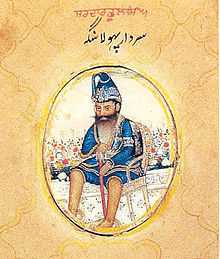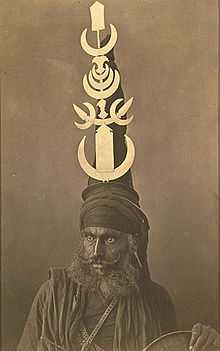Akali Phula Singh
| Akali Phula Singh | |
|---|---|
 | |
| Born |
1761 Shinh, near Amritsar, Punjab, India |
| Died |
1823 Battle of Naushera, Attock, Punjab, Pakistan |
| Known for | Sikh General, Leader of the Nihangs, Adept in kirtan, Extended the boundaries of Sikh Raj, Jathedar of the Akal Takht, Sixth Jathedar of Budha Dal |
| Predecessor | Akali Naina Singh |
| Successor | Jathedar Baba Hanuman Singh Nihang |
| Spouse(s) | Unmarried |
| Parent(s) | Father: Bhai Ishar Singh, Mother: Unknown |
Akali Phula Singh was a nihang serving under the Sikh Empire as a direct adviser to Maharajah Ranjit Singh in the early 19th century.
Biography
The Jathedar of Amritsar
Born in 1761 to Sardar Ishar Singh from a village called Shinh around the city of Amritsar,His surname was Jhand,Akali Phula Singh joined an order of nihang at an early age. At the age of eighteen, Phula was transferred to the fort of Gobindgarh. There, he formed a band of nihang separate from the others serving at the fort. When Phula Singh returned to Amritsar later that year with his band of nihang, he had found the Maharajah to be the new ruler of the city. He and his band of nihang joined the Maharajah and in 1807 he was elevated to the position of the Jathedar of Amritsar. He died in 1823 in battle of Nowshera at Pir sabaq battle fied and his tomb is also located here.
Conflicts with the Maharajah
Europeanisation of the Khalsa Army
Phula Singh was extremely loyal to Maharajah Ranjit Singh, however he respected his religion much more. On the day of Muharram on February 25, 1809 A.D., Shia Muslims of British army under Metcaulf, a British military officer (captain) who was visiting Amritsar along with his forces, decided to take out a procession in the streets of Amritsar, even though in Amritsar among Muslims, majority were Sunni Muslims. It also happened to be the day of Holi, when Nihangs were celebrating Hola Mohalla along with their celebrated leader and Jathedar of Akal Takth, Akali Phula singh. The Shia procession wended its way through the streets of Amritsar, beating their breasts to the chants of "Hassan, Hussein, Ali" They came in front of Golden Temple, where the Akalis were in prayer. The Akalis remonstrated with the processionists to go elsewhere. Arguments led to scuffle and Shia Seopys under Metcaulfe came to a head on collision with Akalis. It is not known who were the aggressors. Even Metcalfe was doubtful and conceded that the first shot was probably fired by one of his Shia escorts. There were about 50 casualties on both sides. In the end this riot stopped when Ranjit Singh who happened to be in the city personally came forwarded and helped to quell the riot. He also went to Metcalfe and apologized for this riot. Ranjit Singh was impressed by the discipline shown by the Shia Sepoys under Metcalfe and Ranjit Singh promptly decided to Europeanise his Army.
Phula Singh was against the Europinisation of Punjab and had argued with the Maharajah for this as he believed that Khalsa forces should moreover follow the fighting styles of Guru Gobind Singh Ji. The Maharajah then signed a treaty with the British marking the border between the British Raj and the Sikh Empire as the River Sutlej. Angered, Phula Singh threatened to quit as he had wanted for the Sikh Empire to retake all of India from the British and wanted the Maharajah to tear the treaty. The Maharajah then calmed the warrior by telling him they would first subdue the Punjab, Kashmir and Tibet before taking on the British.
He was succeeded by Jathedar Baba Hanuman Singh Nihang.
Legacy & Culture

Historically the Akalis were a religious warrior order created by the tenth Guru of the Sikhs Guru Gobind Singh. They fought battles for Guru Gobind Singh and the Mazhabis formed the majority of the Akali Nihang ranks throughout the Guru's period, and even throughout the reign of Maharaja Ranjit Singh.[1] The Akalis were unruly and hard to control and the Sikh Misl chiefs feared them. Throughout the 18th and 19th century they were greatly feared as determined warriors.[2] During the 18th century, when the Mughal and Afghan rulers were hell bent on destroying the Sikhs, the Akali Nihangs were often the most fearless and courageous to challenge them.[3] Under Ranjit Singh's rule, they were renowned both for their intrepid bravery and total lack of discipline except when they were controlled by other Akalis.[2]
The British first came face to face with the Sikh Akalis at the Battle of Ferozeshah during the First Anglo-Sikh War were they earned a notion as "Religious fanatics" among the Sikh army.[4] They kept their swords razor sharp and in battle, at the first opportunity, many of the Sikh foot abandoned their muskets and engaged in hand to hand combat with sword and shield. Horrific cutting wounds, severing limbs and heads, were a frightful feature of the Sikh Wars in which neither side gave quarter to the enemy.[4]
Today the Mazhabi Sikhs continue to join the Akali Nihang ranks in large numbers and still numerically dominate the order.[5] However today the Akali Nihangs survive as a relic and are simply a shadow of their former powerful selves during the 18th and 19th centuries. They continue to maintain old historical traditions and can be found all over the Punjab. They gather once a year at an event called Hola Mohalla where Nihangs from all over Punjab contest their martial skills including swordsman-ship and cavalry exercises.
Today in the Indian Army, The Sikh Light Infantry regiment maintains a Gatka team whom continue to train in the Nihang Martial art. The regiment displayed the Sikh Light infantry gatka team during their joint training exercise with the Chinese army.
Due to the cultural origin of its recruits, the Regiment maintains not only a strong Sikh culture but also a Punjabi culture. The Sikh faith plays a strong role in the day-to-day life and functioning of the regiment and its soldiers. The Sikh Light Infantry maintains its own regimental gurdwara for the daily worship for its soldiers. The Sikh recruits of the regiment have a long and strong standing history with the Sikh religion. The Mazhabi Sikhs had long stood in the armies of the Sikhs' Tenth Guru and in the later Khalsa Army raised by Ranjit Singh.[6] which forged and established the Sikh Empire.
The chakram and Kirpan are iconic weapons of the Nihang and both of these weapons were combined to make the regimental cap badge of the Sikh Light Infantry regiment celebrating the communities Akali Nihang culture and traditions.
References
- ↑ 1.0 1.1 1.2 McQueen. Sir. J.W and Baaghaa. A.S (1994) Unseen faces and untold cases, heroes and villains of Sikh rule, Volume 8 of Series in Sikh history and culture. Bahri Publications p106
- ↑ 2.0 2.1 McLeod, W.H. (2009) The A to Z of Sikhism. Scarecrow Press. p147 ISBN 0810868288
- ↑ Surjit Singh Gandhi. (2007) History of Sikh Gurus Retold: 1606–1708 C.E Vol. 2 of History of Sikh Gurus Retold. Atlantic Publishers. p1002 ISBN 8126908580
- ↑ 4.0 4.1 "Battle of Ferozeshah – The Sikh Wars". Britishbattles.com. Retrieved 2012-10-10.
- ↑ O'Brien. J. (2006) The construction of Pakistani Christian identity. Issue 96 of Publication (Research Society of Pakistan) Volume 1 of Subaltern studies. p426 ISBN 969-425-096-X
- ↑ Sikh army regiments infantry valour war
- "The Heritage of the Sikhs" by Sardar Harbans Singh, ISBN 81-7304-064-8
- "Umdat-ut-twarikh" by Sohan Lal Suri
- "History of Sikhs" Part 1 and Part 2 by Khushwant Singh
| ||||||||||||||||||||||||||||||||||
| Preceded by: Baba Naina Singh |
Akali Phula Singh | Followed by: Jathedar Baba Hanuman Singh Nihang |
| ||||||
